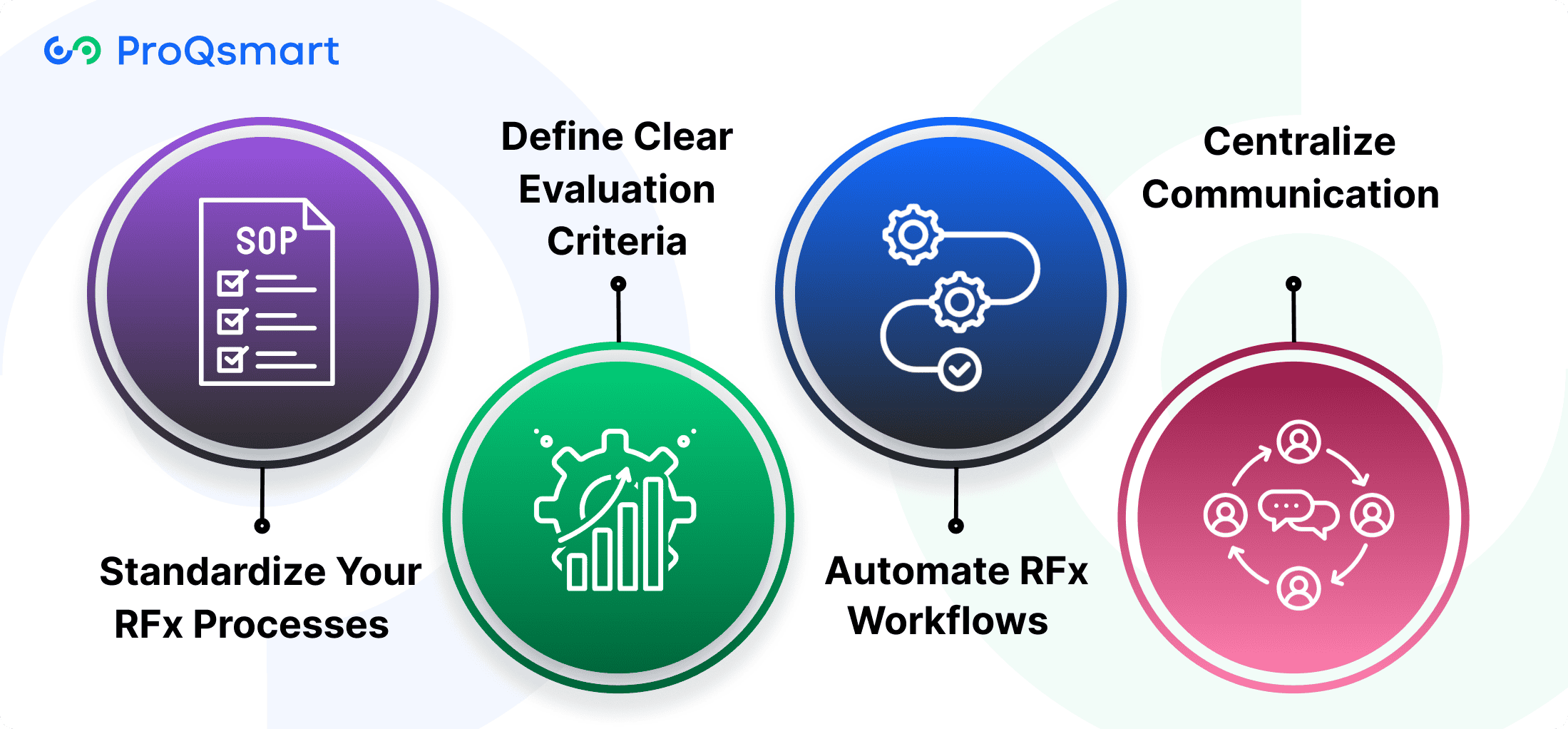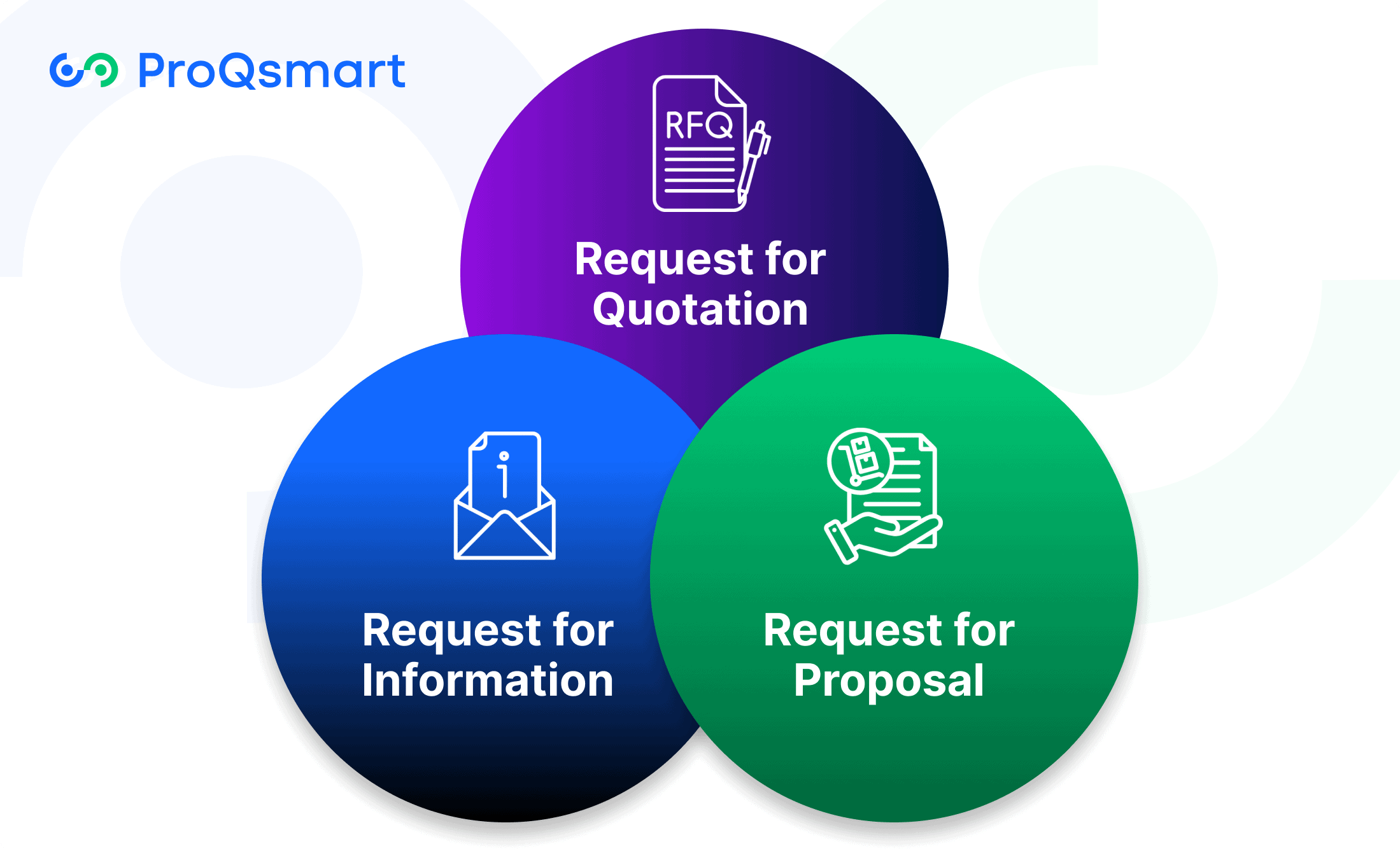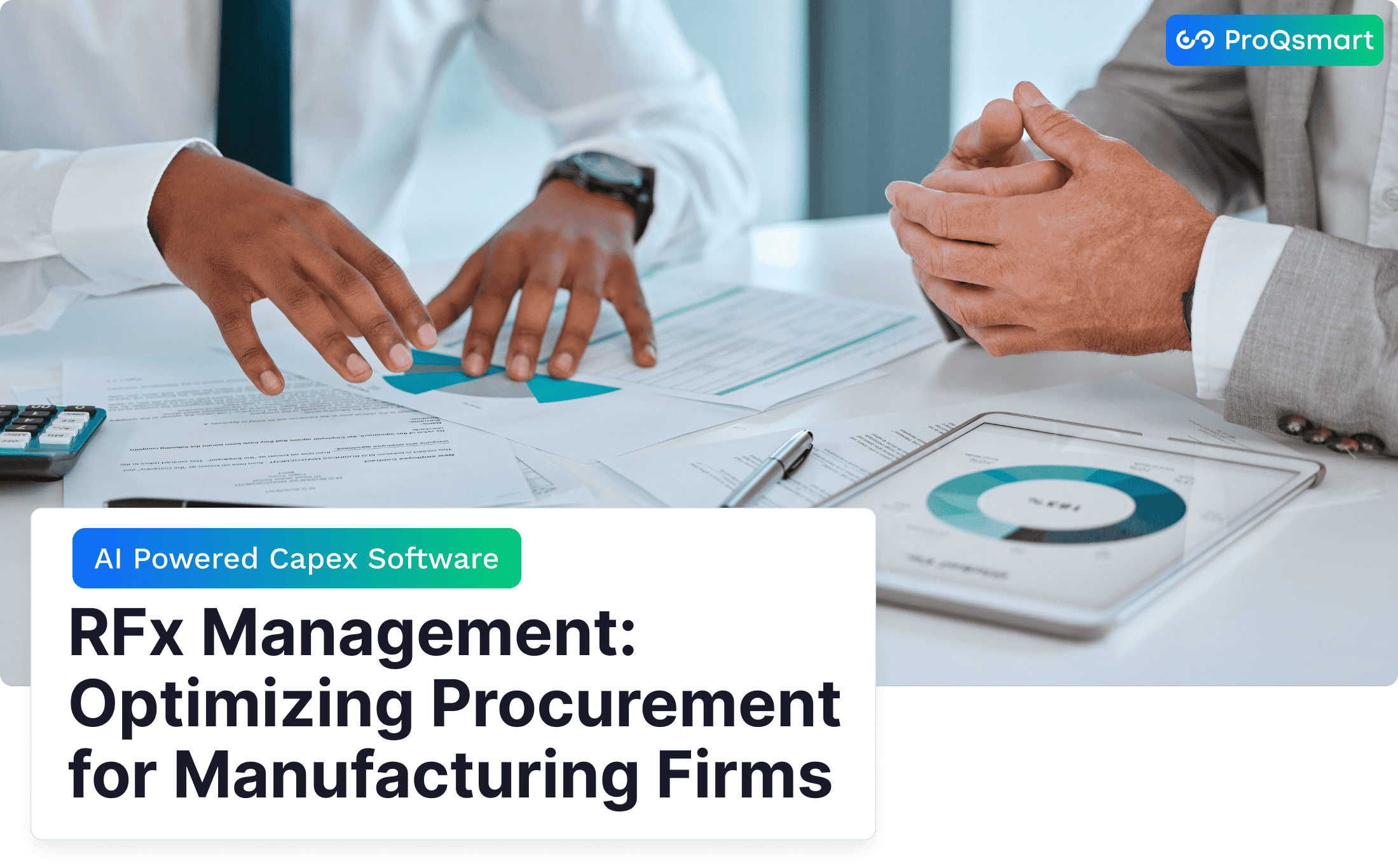Request for Tender RFX management is a formal process that manages the lifecycle of RFI, RFP and RFQ activities. We’ve found this approach to be key in efficiently guiding the procurement/sourcing decisions.
It allows organizations to standardize communication with suppliers, effectively compare supplier proposals, and develop a fair evaluation process with transparency. By orienting themselves to well-defined objectives and evaluation criteria, RFX management eliminates lengthy procurement cycles and improves the precision of vendor selection.
Leveraging tools and technology, such as e-sourcing platforms, further improves efficiency by automating repetitive tasks and tracking key data points. For procurement professionals, truly understanding RFX management is the key to unlocking greater cost savings, risk mitigation, and building more collaborative relationships with your suppliers.
In this article, we’ll dive into actionable strategies and tools to take your RFX workflows from cumbersome to efficient—all while adhering to critical organizational objectives.
What is RFx Management?
RFx management serves as a structured approach to managing Requests for Proposals (RFPs), Requests for Information (RFIs), and Requests for Quotations (RFQs). It’s about generating, issuing and managing these requests to have a more streamlined communication pathway between procurement teams and potential suppliers.
By using this systematic process, procurement teams can ensure procurement workflows are more standardized, creating a greater level of transparency and encouraging improved decision-making.
Core Components of RFx Management
No RFx management software is complete without understanding the fundamental pillars. Document creation is extremely important, that need bottom detailed and precise templates that clearly express requirements, expectations and how proposals will be evaluated to the suppliers.
This is where vendor evaluation comes into play. This is where procurement teams come in and start evaluating responses based on things like cost, quality, and compliance. ProQsmart, for example, makes this much easier with AI-driven smart tools to streamline automated pre-qualification processes and supplier performance monitoring.
Communication strategies take efficiency a step further by providing tools for instant collaboration and keeping all stakeholders aligned across the RFx lifecycle. As with any good process, structured workflows and clear objectives are just as important.
By setting definition goals from the start, you can make sure that each RFx is building toward larger business RFx. ProQsmart’s automated workflows make tracking and reporting a breeze. Their robust analytics and reporting allow for an in-depth view into RFx performance and compliance—all necessary for ongoing improvement efforts.
Importance in Strategic Sourcing
RFx management plays a direct role in strategic sourcing with RFx management helping organizations make better purchasing decisions. Take, for instance, budget-driven procurement—the kind made possible through technology like ProQsmart—which ensures that projects both meet fiscal limits and adhere to a high standard.
Building trust is essential. Consistent, transparent processes develop long-term supplier relationships, building trust and leading to stronger partnerships. Further, integrating tools such as e-tenders and bill of quantities management not only cuts costs, it increases operational efficiency.
Why RFx Management Matters in Manufacturing
RFx management should be table stakes in the manufacturing industry. It’s a strategic and subtle answer to many public procurement challenges and then some. Enhances operational efficiency.
Manufacturing firms face unique challenges when they are looking to source materials and services. These challenges result from ever-evolving supply chain intricacies, intense global market pressures, and high quality compliance requirements. RFx management provides organizations with the frameworks and processes they need to overcome these challenges with precision.
Unique Challenges in Manufacturing Procurement
Manufacturing procurement is never an easy task and is always faced with unpredictable demands, supplier dependency and availability, and constantly changing regulatory pressures. For example, a sudden spike in raw material costs or delayed shipments can halt production lines, leading to financial losses.
Global supply chains add unknowns such as geopolitical risk and currency changes, making it harder to select the right vendor and negotiate contracts. In these situations, management of risk is the key. With a customer-centric perspective, RFx management provides an excellent foundation to address these uncertainties through evaluating supplier capabilities and historical performance metrics.
The Impact of Global Supply Chains
Being part of global supply chains shouts to the clouds how much you need solid RFx management. Specifying across multiple regions needs careful coordination with stakeholders and suppliers to ensure adherence to tight manufacturing schedules.
RFx processes maintain quality consistency by measuring suppliers against established criteria, like certifications and history of performance. Tools like ProQsmart make this easy by automating standard workflows, documentation and compliance, instilling greater operational efficiency in a more competitive era.
Ensuring Quality and Compliance
In manufacturing industry, product quality and regulatory compliance are the must-haves. RFx management brings quality assurance into the fold, encouraging a sense of accountability from your suppliers.
For example, by centralizing supplier data and automating evaluations, ProQsmart helps manufacturers meet industry standards, reduce risk, and maintain transparency throughout procurement cycles.
How Does RFx Management Optimize Procurement?

RFx management is more important than ever in today’s procurement environment, as it encompasses crucial procurement components that streamline the request management process. By implementing standardized approaches and leveraging advanced rfx tools, organizations can minimize inefficiencies while making informed purchasing decisions, ultimately unlocking strategic benefits to thrive in competitive markets.
1. Standardize Your RFx Processes
By standardizing RFx processes, you’re creating a more consistent approach that minimizes ambiguities. Start by creating that set clear expectations from the outset.
Training procurement teams helps to make sure these standards are applied equally, and standardized evaluation criteria help make sure that comparisons are objective. For example, having a consistent scoring rubric for all vendor proposals makes choosing a straightforward decision and minimizes mistakes made due to personal interpretation.
2. Define Clear Evaluation Criteria
Transparent evaluation criteria helps ensure that all vendors are treated fairly, and helps select the best vendor for the job. Define clear evaluation criteria including cost, quality and time to deliver to evaluate bids on a level playing field.
Publishing these criteria from the start gives vendors the opportunity to better tailor their submissions to what you’re looking for, encouraging transparency. Updating these metrics regularly guarantees that they track changing procurement priorities.
3. Automate RFx Workflows
Automation creates a drastic improvement in efficiency, even for the 80% of teams currently using a mostly or entirely manual RFx process. Tools like ProQsmart automate burdensome, repetitive tasks, provide smart notifications, and manage the documentation process.
This not only eliminates manual mistakes, but it helps to drive down procurement cycles so teams can dedicate time towards more strategic efforts.
4. Centralize Communication
A centralized communication platform helps keep all stakeholders up to date. ProQsmart fosters collaboration in real time among cross functional teams and with suppliers, building stronger relationships that lead to better results.
Having a single source of up-to-date information promotes visibility and eliminates communication hurdles between the many stakeholders involved.
Types of RFx Documents

In procurement, RFx documents, including RFP Lite and RFT, allow for a standardized and organized request management process to make vendor engagement easier and the selection process more effective. Understanding their distinct purposes furthers procurement goals and ensures best results in sourcing processes.
Request for Information (RFI)
An RFI is crucial for gathering initial information from potential vendors, providing an overview of their capabilities, products, or services. This rfx document is especially valuable during the solution discovery phase when requirements are not well-defined, facilitating informed purchasing decisions and optimizing sourcing processes.
Request for Proposal (RFP)
RFPs, or requests for proposals, are formal requests for detailed proposals often used in complex, strategic, and high value projects. They offer a transparent process to evaluate suppliers against specific technical, financial, and operational standards.
These advanced features streamline the creation and administration of RFPs through automation, compliance, and cross-team collaboration.
Request for Quotation (RFQ)
An RFQ is a low effort, low risk document that focuses solely on price, making it suitable for standardized purchases such as office supplies. This efficient procurement solution guarantees cost control by obtaining competing vendor quotes based on well-defined procurement needs, streamlining the buying process.
Choosing the Right RFx Type
Choosing the right , as it must align with the project’s complexity, determine the level of detail required, and match the procurement goals. Aligning with the project’s complexity ensures that the RFx process is neither too simplistic for complex projects nor overly cumbersome for simpler ones. Determining the level of detail required helps tailor the RFx to gather the necessary information without overwhelming suppliers or procurement teams.
Finally, matching the RFx type to procurement goals ensures that the process is focused on achieving the desired outcomes, whether it be cost savings, quality assurance, or innovation. By carefully selecting the appropriate RFx type, organizations can streamline their procurement processes, enhance supplier engagement, and ultimately drive better project outcomes.
Key Features of an RFx Management Platform
A cloud-based RFx management platform is the foundation of a modern, agile procurement. It takes cumbersome processes and makes them easy while increasing efficiency and compliance. With its powerful features, this solution unlocks new potential for procurement teams to build stronger vendor relationships.
Moreover, it simplifies workflows and promotes data-driven decision-making across the complete third-party lifecycle.
Centralized Data Repository
A centralized repository of RFx documents, vendor information, and bid responses in one secure cloud-based environment is vital. This greatly enhances accessibility. It improves collaboration with your team and other stakeholders by allowing everyone to see and edit information simultaneously and in real time.
With powerful version control and SharePoint-like collaboration tools, teams can easily track revisions, avoiding costly confusion, saving time and data integrity. Protecting sensitive procurement data with features such as encryption goes a long way toward building trust and ensuring compliance.
Automated Workflow Management
Automation is a key foundation for streamlining processes, minimizing manual errors and speeding up the RFx cycle. Along with customizable workflows and automated triggers, collaboration with internal stakeholders and vendors become streamlined.
For example, they can eliminate tedious manual creation of RFx by up to 80% and submission errors by 90%. Automated progress tracking and deadline alerts keep things on track to maintain timely execution, allowing procurement teams to spend more time on strategic decision-making.
Supplier Portal and Communication Tools
With a dedicated supplier portal, you can create a smooth and efficient experience for potential suppliers with real-time updates and feedback. Intuitive interfaces maximize supplier participation, and features like ProQsmart’s e-tenders allow for easy document sharing and comprehensive bid management.
This simplifies communications with vendors and helps build better relationships.
Integration with Existing Systems
Seamless integration with ERP or CRM systems helps improve data flow across departments and reduce manual entry. Cloud-based platforms, such as ProQsmart, help to centralize the procurement process.
They support sourcing decisions against budgetary requirements and improve risk transparency at the start of the supplier engagement.
Best Practices for Effective RFx Management
Productive RFx management solutions are essential for matching procurement strategies to overarching organizational objectives while encouraging valuable supplier connections. By implementing best practices in the entire procurement cycle, companies can achieve standardization, transparency, and high efficiency across each stage of the RFx.
Establish Clear Objectives and Scope
Setting clear goals before starting any RFx endeavor gives you a plan to follow to ensure success. For example, if the goal is to reduce procurement costs by 15% over six months, this helps set measurable expectations.
Next in importance is defining a clear, comprehensive scope of work. Vendors need a clear picture of the project’s scope, timelines, and deliverables to return their best responses, which is critical for maintaining competition.
Aligning RFx objectives with broader organizational goals is also crucial. Many organizations use procurement to advance strategic priorities, such as sustainability or innovation.
Develop a Comprehensive RFx Template
Ensuring consistency in the procurement process starts with a standardized RFx document template.
-
Project Background: Provide context to vendors about project needs.
-
Detail deliverables, quality standards, and technical parameters.
-
Clarify how proposals will be assessed, covering pricing, timelines, and value-added services.
Ensure Transparency and Fairness
Transparency builds trust, both internally and externally. Clearly sharing your evaluation criteria and not giving preferential treatment are both key to keeping the process fair and open.
Tools such as ProQsmart take this a step further by automating workflows, ensuring auditable sourcing data and enabling seamless collaboration to save significant time and costs. This helps build a relationship of trust with suppliers, and still ensures compliance.
Provide Constructive Feedback to Suppliers
Post-evaluation feedback on supplier responses helps suppliers improve and strengthens long-term supplier relationships. Highlighting areas of excellence and opportunities for growth encourages smart sourcing decisions and is far more productive.
Overcoming Common RFx Challenges
Navigating the RFx process comes with many big hurdles, particularly in request management and procurement procedures. Ignoring these challenges can create procurement bottlenecks and threaten strategic outcomes. By understanding these common obstacles and implementing rfx management solutions, you can turn challenges into opportunities for your RFx process.
Managing Large Volumes of Responses
Even a modest number of vendor responses becomes overwhelming in short order without a clear and consistent structure in place. Keep your invitation list to a maximum of three to six vendors. This helps keep the scope reasonable and results in more detailed and higher-quality responses, which leads to easier evaluations.
ProQsmart and other software tools greatly simplify the handling of responses, categorizing submissions automatically and offering immediate, centralized access for simple evaluation and comparison. Providing specific, non-negotiable due dates or deadlines helps keep the process organized and on track while ensuring responsiveness and consistency in submissions.
Ensuring Data Accuracy and Consistency
Keeping reliable, consistent data is crucial for a fair and open RFx process. Consistency in verification protocols can prevent faulty and incomplete vendor submissions from reaching the table. Data management tools, such as those from ProQsmart, automate document management to minimize mistakes and ensure consistency across all RFx documents.
Conducting regular audits can help improve data integrity, reducing instances of discrepancies and fostering greater trust among stakeholders.
Mitigating Supplier Risks
Supplier risks, such as performance issues or financial instability, can disrupt procurement objectives. Conducting thorough due diligence and leveraging risk assessment tools, such as ProQsmart’s supplier performance monitoring feature, provides valuable insights into supplier reliability.
Proactively addressing risks ensures smoother execution and long-term partnerships.
Handling Complex Requirements
Chunking daunting RFx requirements into more digestible pieces is the key to managing them. Approaching stakeholders to clarify your understanding creates a natural alignment, which lessens the chance of problematic miscommunication.
Giving vendors specific step-by-step guidance will increase the chances of receiving exactly what you envisioned, simplifying the vetting process.
Measuring RFx Success: Key KPIs

A successful RFx management evaluation strategy needs to start with an understanding of what you can actually measure. By establishing and monitoring relevant KPIs, procurement professionals can promote transparency, drive efficiency, and support the overall objectives of their organizations.
These KPIs include reduction of cost savings, time-to-contract, supplier-performance, and stakeholder satisfaction, providing excellent insights and analytics into RFx effectiveness.
Cost Savings Achieved
Effective RFx management contributes to cost savings by encouraging competition through more robust bidding and stronger negotiations through supplier engagement. For example, using e-tendering tools reduces RFX onboarding times, while attracting a higher number of suppliers to participate, often opening the door to significant savings opportunities.
Innovative tools like ProQsmart make the complicated bidding processes much less daunting, promoting transparency and helping to match an organization’s procurement strategies with budget realities. Financial performance KPIs like cost variance or budget adherence deliver real-world information that allows organizations to quantify procurement efficiency.
These smart insights help procurement teams proactively prioritize the highest-value or risk-laden suppliers without losing the speed that low-cost sourcing provides.
Time-to-Contract Reduction
Shortening the time-to-contract is key in dynamic procurement landscapes. By monitoring cycle time KPIs, teams can identify where the bottlenecks are located allowing procurement teams to move RFx phases along quicker without compromising quality.
ProQsmart automates workflows, eliminating redlining confusion for seamless document management and real-time multi-user collaboration to speed contract execution. With less risk of delay from streamlining processes, organizations can continue to be the most competitive.
Supplier Performance Improvement
Additionally, continuing to evaluate supplier performance after the RFx is critical to ensuring long-term success. Metrics like on-time delivery and adherence to contract terms will indicate where execution is lacking or falling short of expectations.
ProQsmart’s supplier performance monitoring provides a consistent supplier evaluation process, preventing miscommunications and growing vendor relationships through a cycle of positive reinforcement and continued engagement. By taking this approach, organizations further solidify supplier relationships to maintain consistent quality and compliance.
Stakeholder Satisfaction
Stakeholder satisfaction reflects RFx success by gauging engagement and communication throughout the process. Involving stakeholders early on and maintaining open dialogue ensures alignment with organizational objectives.
ProQsmart creates transparency, empowering stakeholders with real-time updates, reducing friction, and improving decision-making.
Conclusion
RFx management enables procurement to take command of the process with speed and transparency. It automates and centralizes the way you manage bids, proposals and supplier engagement. Leveraging better tools and smarter practices will save you money and time, energy and effort. You’ll find plenty more, including the top suppliers to fit your needs. By prioritizing goals and measuring essential metrics, you can make certain that each move contributes value to your journey.
Great RFx management isn’t just about the tools—it’s about strategy. It helps you focus your decision making with your overall business objectives and improves your relationships with your suppliers. Whether you’re just trying to refine existing workflows, or you’re overcoming challenges faced by many, RFx management paves the way for more strategic sourcing and improved outcomes.
Discover how ProQsmart’s RFx management can help you meet today’s goals and provide your procurement strategy with a sustainable competitive advantage. Book a demo today!




